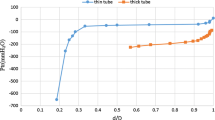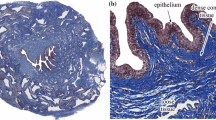Abstract
We have used a series of urethral models to test a theory of flow through distensible tubes having a pressure maximum (elastic constriction) near the midpoint. From measurements of pressure head and flow rate the properties of each elastic constriction have been deduced by means of the theory, and have been compared with those known from static measurements (paper I). For models with a sufficiently broad elastic constriction the theory is correct. Increasing departures occur as the elastic constriction becomes more sharply localised. In particular, pressures measured by a static method, similar to the Brown-Wickham method used clinically, become greater than those deduced from the flow measurements. Similar behaviour is expected for the real urethra, and may be important in the understanding of incontinence. These models show the negative-resistance behaviour believed to be characteristic of sharply localised elastic constrictions.
Sommaire
On a utilisé une série de modèles urétraux pour expérimenter une théorie selon laquelle l'écoulement à travers des tubes dilatables atteindrait sa pression maximum (constriction élastique) près du milieu. A partir de mesures de la hauteur manométrique et du débit, les propriétés de chaque constriction élastique ont été déduites, selon la théorie, et comparées à celles obtenues par des mesures statiques (lère partie). Pour les modèles ayant une constriction élastique suffisamment large, la théorie est correcte. On trouve des divergences croissantes au fur et à mesure que la localisation de la constriction élastique se précise. En particulier, les pressions relevées par une méthode statique, analogue à la méthode clinique Brown-Wickham, dépassent celles déduites à partir des mesures de débit. On attend un comportement similaire du vrai urètre, et ceci peut être important pour la compréhension de l'incontinence. Ces modèles montrent le comportement à résistance négative qui semble caractériser les constrictions élastiques qui se localisent nettement.
Zusammenfassung
Wir haben mehrere Modelle einer Harnröhre verwendet, um die Durchflußtheorie durch dehnbare Röhren zu prüfen, die einen maximalen Druck (elastische Verengung) in der Nähe des Mittelpunktes aufweisen. Von Messungen des Drucks und der Durchflußmenge wurden die Eigenschaften jeder elastischen Verengung mittels der Theorie abgeleitet und mit den aus statischen Messungen bekannten Merkmalen verglichen (Teil 1). Bei Modellen mit einer ausreichend weiten elastischen Verengung trifft die Theorie zu. Wachsende Abewichungen findet man vor, wenn die elastische Verengung schärfer lokalisiert ist. Insbesondere sind die durch ein statisches Verfahren, ähnlich dem klinisch verwendeten Brown-Wickham-Verfahren, gemessenen Drücke größer als die aus Durchflußmengenmessungen abgeleiteten Werte. Ein ähnliches Verhalten wird bei der echten Harnröhre erwartet, was wesentlich zum Verständnis der Inkontinenz beitragen kann. Diese Modelle zeigen das negative Widerstandsverhalten, von dem angenommen wird, daß es für scharf lokalisierte elastische Verengungen charakteristisch ist.
Similar content being viewed by others
References
Brown, M., andWickham, J. E. A. (1969) The urethral pressure profile.Brit. J. Urol. 41, 211–217.
Griffiths, D. J. (1971) Hydrodynamics of male micturition—I. Theory of steady flow through elastic-walled tubes.Med. & Biol. Engng. 9, 581–588.
Griffiths, D. J. (1973) The mechanics of the urethra and of micturition.Brit. J. Urol. 45, 497–507.
Griffiths, D. J. (1975a) Negative-resistance effects in flow through collapsible tubes: Part 1. Relaxation oscillations.Med. & Biol. Engng. 13, 785–790.
Griffiths, D. J. (1975b) Negative-resistance effects in flow through collapsible tubes: Part 2. Two-dimensional theory of flow near an elastic constriction.ibid. 13, 791–796.
Griffiths, D. J. (1975c) Negative-resistance effects in flow through collapsible tubes: Part 3. Two-dimensional treatment of the elastic properties of an elastic constriction.ibid. 13, 797–802.
Martin, S. andGriffiths, D. J. (1976) A model of the female urethra: Part 1. Static measurements of pressure and distensibility.ibid. 14, 512–518.
Author information
Authors and Affiliations
Rights and permissions
About this article
Cite this article
Martin, S., Griffiths, D.J. Model of the female urethra: Part 2—Flow properties. Med. & biol. Engng. 14, 519–523 (1976). https://doi.org/10.1007/BF02478049
Received:
Accepted:
Issue Date:
DOI: https://doi.org/10.1007/BF02478049




